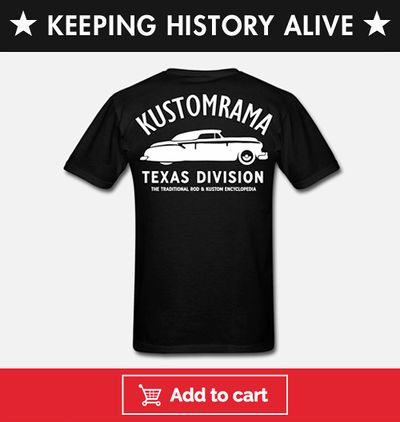George Jezek's 1949 Chevrolet 2-Door Sedan - The Candy Cart


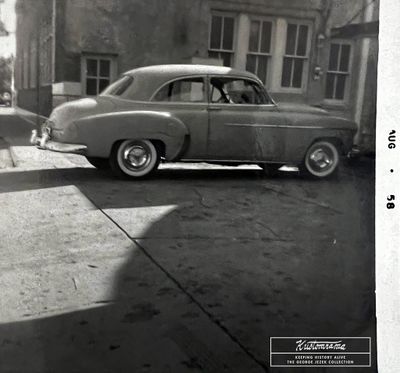
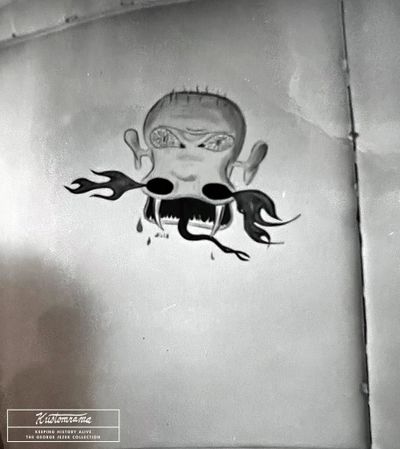

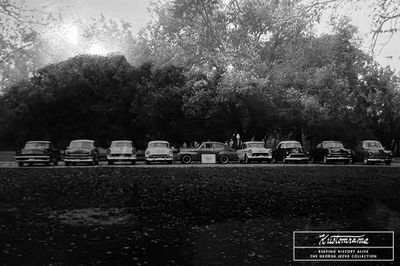



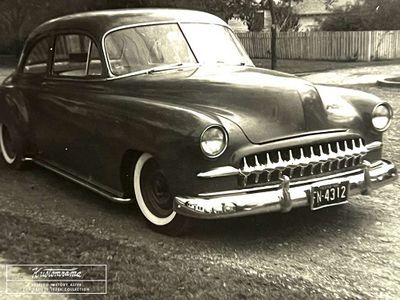


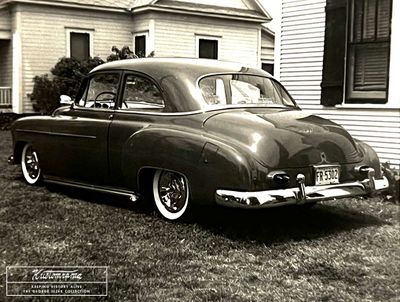






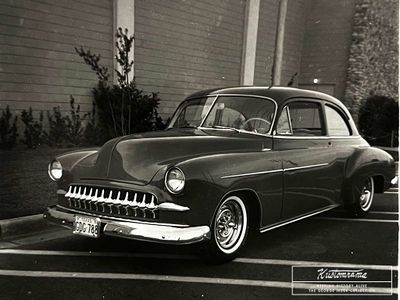
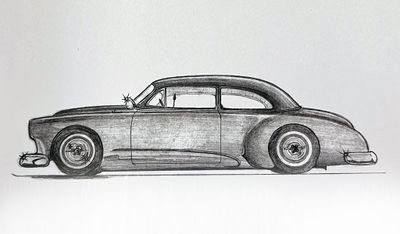
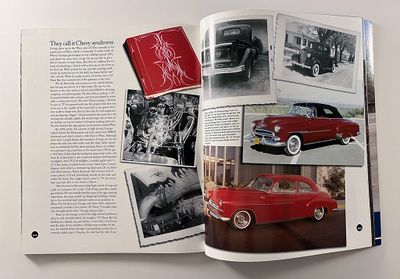
Featured Stories - 1949 Chevrolet
1949 Chevrolet 2-Door Sedan owned and restyled by founding Eliminators of West car club member George Jezek of West, Texas. The car underwent multiple transformations under Jezek's hands, becoming a featured magazine car in the 1960s.
Contents
Background
Jezek hails from the small town of West, located approximately 15 miles from Waco in central Texas. George's passion for hot rodding ignited around 1955. At the age of 14, he obtained a driver's license, a common practice in rural Texas at the time. His first vehicle, a Chevy pickup with the iconic bow tie emblem, was more of a necessity than a passion. Recognized as the class artist, Jezek began practicing pinstriping, and it didn't take long before his 1935 Chevrolet had been hand-painted black and adorned with white pinstripes using a watercolor brush. His subsequent Chevy, a '46 model acquired in 1957, was painted under the shade of a tree in his gravel driveway using two fly sprayers. George got a proper sword brush, and his proficiency in pinstriping grew into a salable skill. He often striped cars in front of his father's ice house/market and became the go-to sign painter for businesses in West.[1]
Late in 1959, after graduating, George co-founded the Eliminators of West rod club. This NHRA chartered club boasted a rented shop in town. Despite having numerous members, George was one of the few who actively utilized the shop. He spent his after-school hours and weekends there, painting designs on customers' cars. Jezek purchased the Chevrolet in August 1958, during his senior year of high school. He paid $250.00 for the car on $10.00 a week in installments. Reflecting on the early days of his project, Jezek told Sondre Kvipt of Kustomrama, "I immediately started customizing the car. Most of the work was accomplished in a gravel driveway under a shade tree next to my parents' house." With limited tools and resources, Jezek often relied on his high school shop class for heavier tasks, such as welding.[2]
First Phase of Customization
Jezek's initial modifications to the Chevrolet were moderate. He nosed and decked it, installed 1950 Pontiac taillights, and adorned the wheels with Olds Fiesta hubcaps. The car also received an enamel paint job. Jezek fondly recalled his early experiments, stating, "I soon discovered Bondo and was off and running." The interior was revamped with a budget black and white vinyl design, a Sun tach, Stewart-Warner gauges and an Ansen floor shift. Under the hood, the original engine was replaced with a bored 235 Chevy 6, enhanced with features like a milled head, dual carbs on an Offenhauser intake, split exhaust manifold, a Spalding cam, and a Mallory ignition. The car was lowered 4" in the front and 3" in the back to complete the look.[2]
Second Phase of Customization
The Chevrolet's second transformation saw even more intricate changes. Jezek added frenched 1952 Ford headlights, twin spotlights, rounded hood corners, and a molded grille shell with thirteen 1953 Chevy teeth. "I had to trim the flanges of each one narrowing them to fit." The rear of the car was adorned with frenched-in 1959 Caddy taillights. Inside, a solid white rolled and pleated interior was installed. The upholstery work was done by a guy by the name of Forrest from Cleburne, Texas. "His customer base was the Dallas, Ft. Worth area," George recalled. In addition to the interior, the package tray and the back of the front seats were also upholstered in rolls and pleats. "The carpet was black with white binding. Forrest made white brake, clutch, and accelerator pedal covers for show only." The exterior was painted in a striking Buick Seminole Red Lacquer. "I earned money for this hobby pinstriping cars and this one had some of my striping," Jezek noted. Additionally, long lakes pipes and Dodge Lancer hubcaps with bullets were added for a lower look and an extra touch of flair.[2]
Recognition and Final Changes
Jezek's custom Chevrolet didn't go unnoticed. It was featured in three "little pages" magazines between 1960 and 1961. Jezek proudly mentioned, "Starting to get serious now and winning my class in several Autorama Car Shows." A photo developed in November of 1961 shows it running chromed wheels with Spider caps. The wheels were from a 1957 Chevrolet, and George had them chromed by a shop in Waco. In 1962, the car underwent its final major transformation. A warmed-over 283 Chevy V8 engine with a Duntov cam and four Stromberg carbs were installed along with loads of chromed parts and accessories, making it not just a showpiece but a powerful drive. "Along with pinstriping, I did sign painting and swapped signs for plating for the most part," George told Kustomrama. As times and trends were changing, the 1962 version only featured subtle white pinstriping around the front wheel well. By now, the dual spotlights and the long lakes pipes were also gone. In addition to this, George also removed the 1959 Cadillac taillights and replaced them with 1958 Ford lenses, "which fit the frenched housing perfectly." The undercarriage was painted red, and it ran one-piece bumpers.[2]
Later Years
By 1967, life had changed for Jezek. He made the difficult decision to sell the beloved Chevrolet as he and his wife began their family. George sold it at the Dallas Autorama. He can't remember who he sold it to, but they guy was from Big Springs, Texas. "He sold it to someone in El Paso and then I lost track of it." After selling the Chevy, George's passion for cars remained undiminished. "I have built 18 cars since then, some restorations and mostly hot rods. Still have a few," Jezek shared, highlighting his lifelong dedication to the craft.[2]
Magazine Features and Appearances
Rodding & Re-styling March 1960
Car Speed & Style May 1961
Rodding & Re-styling May 1961
The Rodders Journal 15
References
Did you enjoy this article?
Kustomrama is an encyclopedia dedicated to preserve, share and protect traditional hot rod and custom car history from all over the world.
- Help us keep history alive. For as little as 2.99 USD a month you can become a monthly supporter. Click here to learn more.
- Subscribe to our free newsletter and receive regular updates and stories from Kustomrama.
- Do you know someone who would enjoy this article? Click here to forward it.
Can you help us make this article better?
Please get in touch with us at mail@kustomrama.com if you have additional information or photos to share about George Jezek's 1949 Chevrolet 2-Door Sedan - The Candy Cart.
This article was made possible by:
SunTec Auto Glass - Auto Glass Services on Vintage and Classic Cars
Finding a replacement windshield, back or side glass can be a difficult task when restoring your vintage or custom classic car. It doesn't have to be though now with auto glass specialist companies like www.suntecautoglass.com. They can source OEM or OEM-equivalent glass for older makes/models; which will ensure a proper fit every time. Check them out for more details!
Do you want to see your company here? Click here for more info about how you can advertise your business on Kustomrama.
